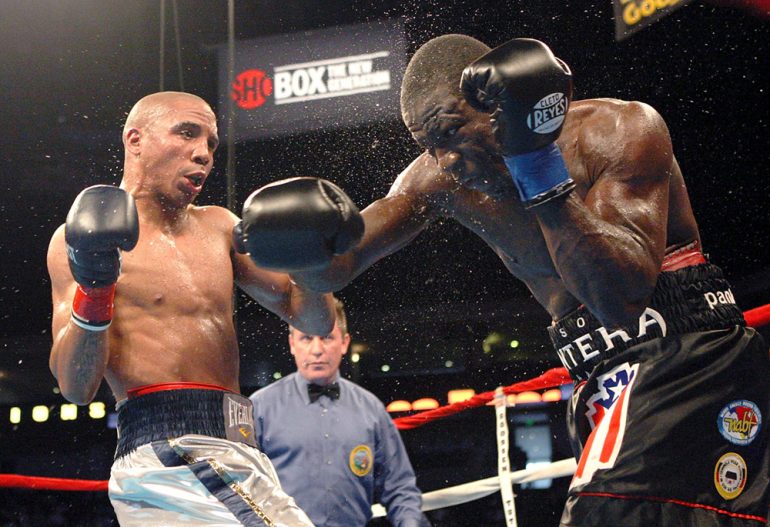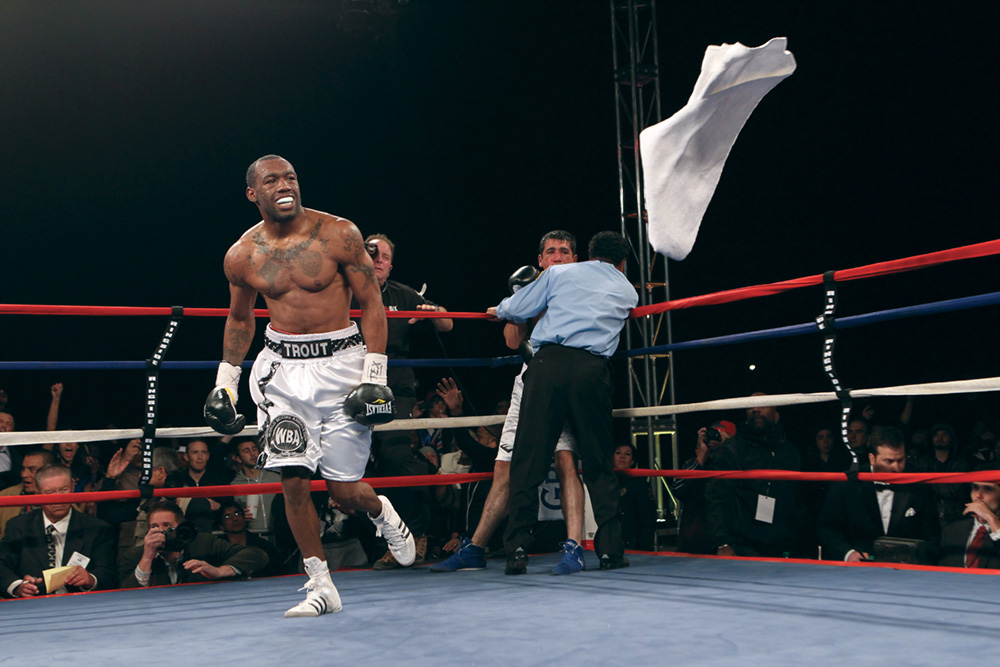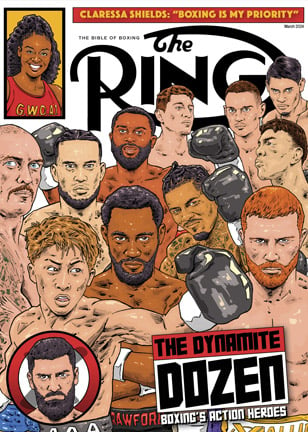ShoBox: Where no show had gone before

This was the cover story in a Ring special issue celebrating the 20th anniversary of ShoBox: The New Generation coming this Friday
AN UNLIKELY BOXING INSTITUTION AND ITS 20-YEAR JOURNEY WAS SPAWNED OVER A DINNER BETWEEN A PROMOTER AND A NETWORK EXECUTIVE
Gary Shaw shook his head as the Lincoln Tunnel lights flashed in sequence through his car. Grumbling under his breath and despite trying earnestly to convince himself otherwise, the promoter wasn’t optimistic that his proposal had gone well.
Shaw was fortunate enough to have one believer in his wife, Jude. It made the 45-minute ride home to Wayne, New Jersey, one spring Friday night in 2001 far more palatable. Little did Shaw know he had another in Jay Larkin, whom he’d just had dinner with.
The idea put on the table that night in a dim basement Italian restaurant in Manhattan has since blossomed for two decades, establishing a staple of boxing in SHOWTIME’s ShoBox: The New Generation. This July marks the 20th anniversary of the series, which has televised fights from Temecula, California, to London and everywhere in between.
A remote control in one hand and Diet Coke in the other, Shaw came up with the concept on his den sofa one April night in 2001. From there, the idea found its way to the social interlude with Larkin – the late, beloved SHOWTIME senior vice president – then into the capable hands of Gordon Hall and finally onto the TV screens of cable subscribers across the U.S.
It has produced 84 world titlists over 258 shows. It has allowed 15 fighters who lost on ShoBox to rebound and become world titlists themselves (Luis Collazo, Robert Guerrero, Eric Aiken, David Diaz, Isaac Hlatshwayo, Cornelius Bundrage, Rodrigo Guerrero, Ishe Smith, Gamaliel Diaz, Mickey Bey, Badou Jack, Caleb Truax, Ray Beltran, Tevin Farmer and Yordenis Ugas).
Most importantly, though, it has provided young, untested fighters a rare, high-profile proving platform during their gestation phase. And it’s the only show of its kind with such longevity.
The funny thing is, no one initially involved thought ShoBox would survive this long. It’s actually a continuing tribute to Larkin’s belief in the series, Hall’s vigilant guidance over the last two decades and President of SHOWTIME Sports Stephen Espinoza’s unbending faith in ShoBox.
Even Shaw himself thought the idea might be dead before he’d made it through the Lincoln Tunnel.
“This is tough to remember everything back then, because I never thought anything was going to happen when I brought the idea up to Jay,” recalled Shaw, now 76. “I was sitting on the sofa, channel-hopping one Saturday night, and I started to get disgusted with what I was seeing.
“I would sit around and see the same fighters in the same fights, over and over. Fights that you knew who the winner would be before they fought. How could we develop the next Lennox Lewis or next Floyd Mayweather? Because there were no outlets willing to show young, up-and-coming fighters in tough.”
“Fighters have some of the most compelling backstories in sports. Their stories weren’t being told.”
– Gary Shaw
The next morning, Shaw threw out an idea to his son, Jared. Jared’s reaction: “I love a farm team.”
But where to go with this? Who to talk to?
“I remember telling Jared I didn’t think anyone was going to buy it,” Shaw said. “Everyone was looking for name fighters, and it’s why I thought the idea would fail. If there wasn’t a name attached, it wouldn’t have much success.”
A few weeks later, Shaw made dinner reservations with a “name” man in the boxing business at a Manhattan Italian restaurant. Shaw and Larkin were friends. They could talk candidly with one another sans deflectors. They were a good pair, both stubby and energetic and approachable, once you peeled back the layers.
Both could also be as pugnacious as the fighters they dealt with – and also very meticulous.

Future British stars, including Carl Froch, made their U.S. TV debuts on ShoBox.
Larkin kept a small, leather-bound notebook with him and jotted down everything. If he didn’t have it on him, chances are the notebook would be filled the next morning if Larkin heard something he liked. Every meeting was in that notebook, whether the person Larkin spoke to knew it or not.
What Shaw was about to tell him was notebook-worthy.
Shaw, Jude, Larkin and his wife, Lisa, were enjoying their dinner when, at some point, Shaw saw his chance. He leaned over the red table cloth and gave his pitch.
After a moment of reflection, Larkin blurted out that he loved it – with the caveat that English promoter Frank Warren be involved. Larkin was very close to Warren and asked Shaw if he would be opposed to giving up some dates to his dapper pal.
“Of course I wasn’t,” Shaw said. “If I got one date from SHOWTIME, it would be one date more than I had. We decided to start out in Atlantic City, and I wanted to do the fights in black-and-white, to give it an old-time feel. But that idea got thrown out. The goal was 12 to 14 dates a year.”
Shaw also felt compelled to go to HBO. He approached them about it, just to be fair. HBO had zero interest. He remembers being on a speaker phone with them and stressed that dismissing the notion would be a big mistake. HBO was waiting for ESPN at the time to provide them with new faces.
“HBO only wanted to deal with the very top,” Shaw said. “Well, when you’re dealing with the very top, there’s a long fall down. In retrospect, I was right and SHOWTIME was the winner. HBO wasn’t even willing to listen.”
Twenty years later, SHOWTIME CHAMPIONSHIP BOXING and ShoBox still exist. HBO got out of the boxing business in 2018, after 45 years.
“One of the biggest mistakes boxing was making was picking winners and losers, where some networks would only deal with Al Haymon or Bob Arum (as exclusive partners on their respective network), which cut out other promoters who also had talent,” Shaw said. “I also thought boxing was hurting itself by cutting out the backstories of these fighters.
“Fighters have some of the most compelling backstories in sports. Their stories weren’t being told. Jay and SHOWTIME were not only willing to develop rising talent, but to tell their stories through ShoBox. That was part of why Jay wanted it.”
After Larkin and Shaw shook hands on the proposal, Shaw had one big problem: How was this going to unfold?
“I always have a belief in Gary, but that night driving home from our dinner with Jay and Lisa, I remember Gary asking me, ‘Do you really think this can be pulled off?’” recalled Jude Shaw, who’s been married to Gary for 43 years. “I remember telling him that he could do it. Gary really didn’t think he could, but once he puts his mind to something, he doesn’t let go.”
Neither did Larkin.
***
If ShoBox belongs to anyone, it belongs to Hall, ShoBox’s executive producer. Shaw placed the concept on the table. Hall, who Shaw admits grew ShoBox, ran with it. Larkin had the faith to lure Hall over from NBC Sports, where he was a production manager working on golf and football. Hall was also a production manager for NBC’s Sports World, doing boxing with Marv Albert and Ferdie Pacheco.
Hall came to SHOWTIME in 1990 with knowledge, experience and a passion for boxing. Prior to him arriving, the cable giant used to contract out production teams to produce and package its boxing telecasts. When SHOWTIME decided to go in-house instead, it was Hall who hired the engineering staff and mobile units, coordinated the transmission and oversaw the production management and packaging of his first fight, which was Evander Holyfield against Seamus McDonagh on June 1, 1990, at Boardwalk Hall in Atlantic City, New Jersey.
In mid-2001, Larkin called a staff meeting to broach this new idea for a boxing series.
“I’m the beginning we had only two promoters, Gary who was with Main Events and Frank Warren. It was difficult matching the fighters in the early years,” Hall said. “I always had differences of opinions on how we should match the fighters. Matching fighters is always a negotiation.

Heavyweight prospects Eddie Chambers (right) and Dominick Guinn met on May 4, 2007. (Photo by Denise Truscello/WireImage)
“The challenges in the early years was to not just take what was given to us but to try to negotiate to make a good matchup. Both Main Events, and later Gary Shaw Promotions, and Warren no doubt had talented fighters, but could we make competitive matchups?
“What strengthened ShoBox over the years was when we became an open house. It allowed us to create competition among promoters and gave us more leverage with making step-up fights. I want fighters to be matched as tough as possible. It’s not an easy conversation and not an easy one to win.”
As Hall sat there when Larkin first brought up ShoBox, he admittedly had his doubts. Many in the boxing industry liked the idea, though they all repeated the same mantra to Hall: “a great idea that wouldn’t last.”
“Jay Larkin looked around the room and he thought I would be a good person to be the executive producer on it, but he probably thought the thing would only last a few years anyway,” Hall said. “Who would have thought that a series with unknown fighters in the infancy of their careers in hopefully competitive matchups would capture the attention of boxing fans?
“At first, everybody was excited to see a new series of boxing, but because of what it was perceived to be, there was doubt whether it would last. I was willing to give the series every bit that I had, and I have, to make this series succeed. I did have my doubts, but that came because of the difficulty working with matchmakers to make these fights.
“ShoBox is not about the names like SHOWTIME CHAMPIONSHIP BOXING. It’s easy to get behind the sexy fights. Both internally at SHOWTIME and externally with the press, ShoBox is harder to sell, but if you can reinforce the purpose and definition and make competitive matchups regardless of the names, people will buy into it. Fans want to see competitive matchups and stars of tomorrow, and time has validated what we set out to do 20 years ago.
“Everyone who works on this series at SHOWTIME SPORTS is proud of what we have done. I just don’t believe 20 years have gone by. We didn’t even have a name for the series when Jay first brought it up.”
Hall, along with Sheila Mills, SHOWTIME vice president of sports marketing; Marina Capura, head of SHOWTIME sports public relations; and Earl Fash, SHOWTIME’s vice president and creative director, came together to call the new show ShoBox: The New Generation.
SHOWTIME originally wanted ShoBox: The Next Generation, but couldn’t get the trademark because Star Trek: The Next Generation already owned it. That’s how the quartet decided on ShoBox: The New Generation.
If ShoBox is Hall’s baby, Hall of Fame announcer Steve Farhood is certainly ShoBox’s godfather.
Farhood was chosen as the series’ analyst from a group of other possibilities that included former champions and respected writers. Nick Charles was the original blow-by-blow announcer for ShoBox, and he gave the series instant credibility.
But who to fill the analyst position?
Farhood, a former editor of The Ring, was an easy fit. He came with great storytelling ability and an acute eye for the sport.
“I was thinking ShoBox was a great idea and I wanted to be a part of it for a couple of reasons,” Farhood said. “SHOWTIME is the highest level of production and I wanted to be with the best. Nick was hired early on in the process, and I was hired pretty late.

Austin Trout improved to 24-0 after stopping Frank LoPorto in six rounds in November 2011.
“In the beginning, we did have doubts, because it was a new venture. We provide young fighters with exposure and activity. I think when you’re in an industry for over 40 years, you become associated with certain things. But I’ve been more closely associated with ShoBox than anything else and proudly so. It’s a show that’s needed.”
And still going.
Espinoza is in his 10th year at SHOWTIME. He continues to be committed to ShoBox.
“All of us here at SHOWTIME are incredibly proud of the franchise,” Espinoza said. “I believe ShoBox is the strongest brand in boxing. When a boxing fan hears ShoBox, they know exactly what that means. It has currency, value and identity throughout the sport.
“It was literally created from nothing with just an idea. Gordon Hall, (director) Rick Phillips, (producer) Rich Gaughan and (production operator) Joe Jacovino have been there since the beginning, along with Steve Farhood. We take an amount of pride in the series, but those guys have spent the bulk of their careers on ShoBox.
“As a director, one of the more challenging and enjoyable things is to launch a new show,” said Phillips. “With ShoBox, that experience was even more special because of the type of show. There’s always been an honesty and clarity about the ShoBox mission to showcase up-and-coming fighters, and it’s great to be a part of creating champions.
“On a personal level, it’s been a terrific experience. I’ve made lifelong friends here on ShoBox; besides being consummate professionals, the production and technical crew are just really good people and great to be around.”
“I thought the concept of ShoBox was terrific and long overdue,” added Gaughan. “These fighters were often ignored and buried under more significant matches. With ShoBox, they would take center stage.
“I have traveled to places unfamiliar to most and had the unique opportunity to speak to and watch young, unknown fighters put it all on the line chasing their dreams. I have witnessed specific moments of very human responses to adversity. Some rose to the occasion while others crumbled.
“I can’t help but root for the fighters who have passed through our show and somehow take pride in their accomplishments. I see so many champions, like Tyson Fury, Deontay Wilder and Regis Prograis, and think: I knew them when.”
At 5 p.m. on Saturday, July 21, 2001, the first ShoBox appeared at Bally’s in Atlantic City. The first fight featured John Molnar (18-1-1) scoring an eight-round technical decision over Victor Rosado (17-2-1). The ring announcer was Amy Hayes. In the main event, lightweight Leo Dorin (17-0) stopped Martin O’Malley, also 17-0, in the ninth round.
Six months later, Dorin won the WBA lightweight belt, becoming the first ShoBox fighter to win a world title.
It defined ShoBox.
“I would definitely say ShoBox exceeded everyone’s expectations, and what validates the series for me is that boxing fans love the series,” Hall said. “When Stephen Espinoza landed at SHOWTIME 10 years ago, he could have easily canceled ShoBox and used that money for something else. He did not.
“It’s lasted this long. That says something.”

Joseph Santoliquito is an award-winning sportswriter who has been working for The Ring Magazine/RingTV.com since October 1997 and is the president of the Boxing Writers Association of America. He can be followed on Twitter @JSantoliquito.
READ THE MARCH ISSUE OF THE RING FOR FREE VIA THE NEW APP NOW. SUBSCRIBE NOW TO ACCESS MORE THAN 10 YEARS OF BACK ISSUES.
















